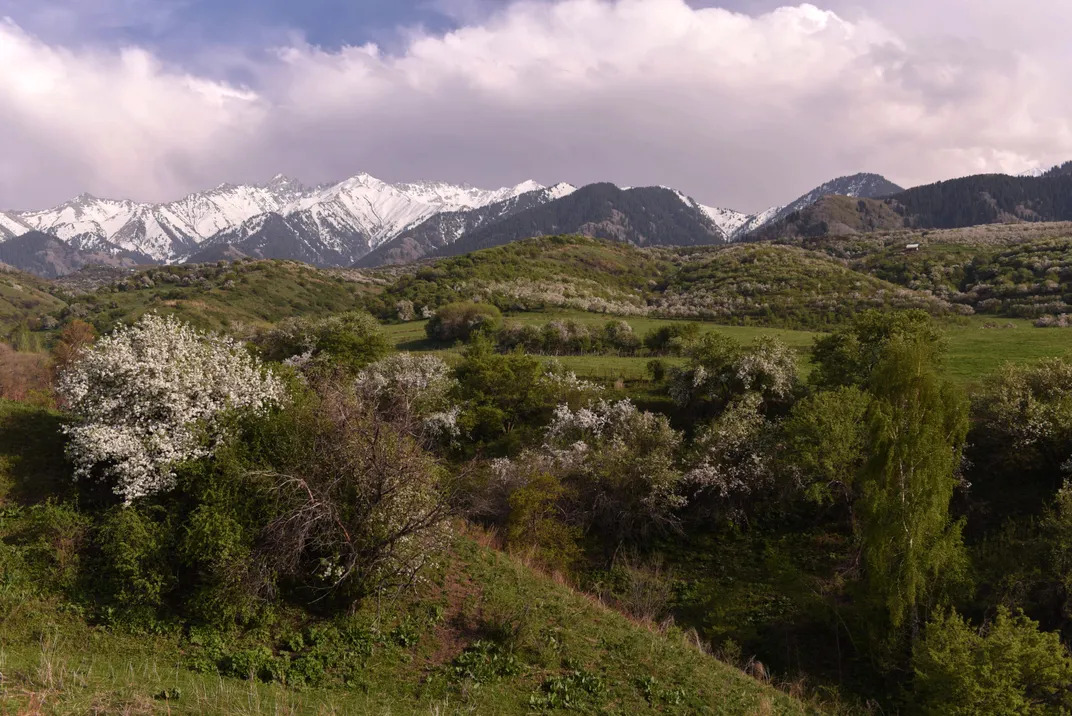The apple’s history dates back to the ancient Tian Shan Mountains in Kazakhstan, where it was initially grown. The region is home to Malus sieversii, the wild ancestor of today’s apples. People who traveled along the Silk Road unknowingly carried apple seeds, which grew and gave birth to numerous varieties of this fruit. These seeds, from wild trees, were selectively abandoned by traders and other travelers along the Silk Road, paving the way for several thousand modern apple species.

While the exact number of Malus sieversii is unknown, the bulk remaining in Kazakhstan grow freely and untamed. Photo credit: Maxim Pushkarev/Alamy
It may seem strange initially because we are used to thinking of “apple” and “universal” as going together. Their ancestor, Malus sieversii, grows abundantly in Tian Shan. In tracing back the genome of an apple, biologist Nikolai Vavilov discovered that it originated near Almaty, Kazakhstan, during the early 20th century. His discovery of an orchard made up primarily of wild trees densely growing, unlike any other place, showed how unique this genetic reservoir is in Kazakhstan.

Muhammad Ali Pasha.
Beyond historical import, this genetic legacy is of significant importance.
The ancient apple forests in Kazakhstan may be instrumental in saving the world’s apple industry, worth about $50 billion a year. These forests, with their untouched genetic combinations, have potential answers to new problems such as apple diseases, which are less frequent in these native trees due to their long separation from other apple types.
The journey of the apple through history continued, as seeds were naturally spread mainly by birds and bears before humans started cultivating them. By the time people started growing and trading apples, Malus sieversii had already settled in Syria. The Romans encountered this variety of apples and further disseminated it throughout the world, greatly influencing its distribution and cultivation.
Modern scientific activities like genome sequencing have proved that Almaty and its environs can be regarded as the cradle of apple species’ origin. The name Almaty, meaning “father of apples,” indicates its glorious past, and local markets sell different varieties of domesticated apples, according to Ms. Rebecca Rupp. A Malus sieversii tree itself bears testimony to the origins of an apple when you look at its features, such as big yellowish-green fruit or autumn-red leaves.
Further apple genome research has shown that the Malus sieversii was large and genetically diverse, making it a base for hybridization with European crabapples. This process, in combination with selective breeding, led to modern apples that are bigger, harder and more delicious. As compared to other cultivated fruits, which went through cultivation-based growth in size increase, the wild apple, its ancestor, was already medium-sized to large, hence its domestication without much size selection.
In conclusion, the story of the apple takes us back to ancient times, scientific discoveries, and continuous evolution. From Kazakhstan’s roots to global eminence today, this voyage highlights how nature intertwines with human activities and scientific advancements. The ongoing exploration of its genetic diversity holds promise for further advances in apple cultivation and breeding.
The author is the patron-in-chief of The Gulf Observer and an expert on Central Asia, Belt and Road Initiative, China and Southeast Asia (Pakistan).


